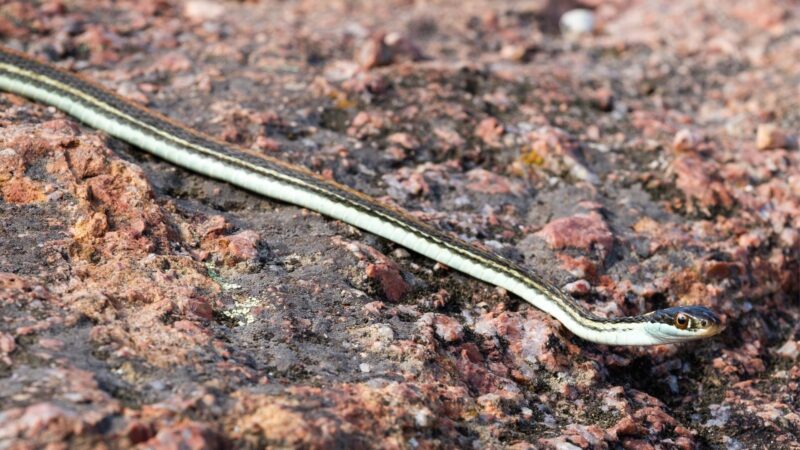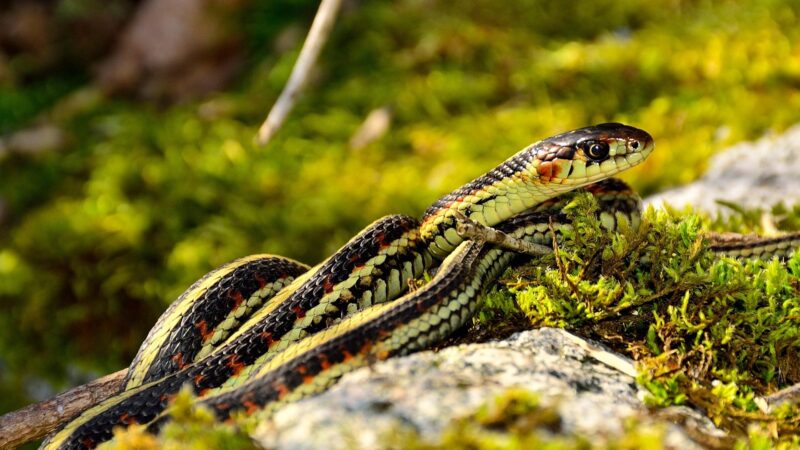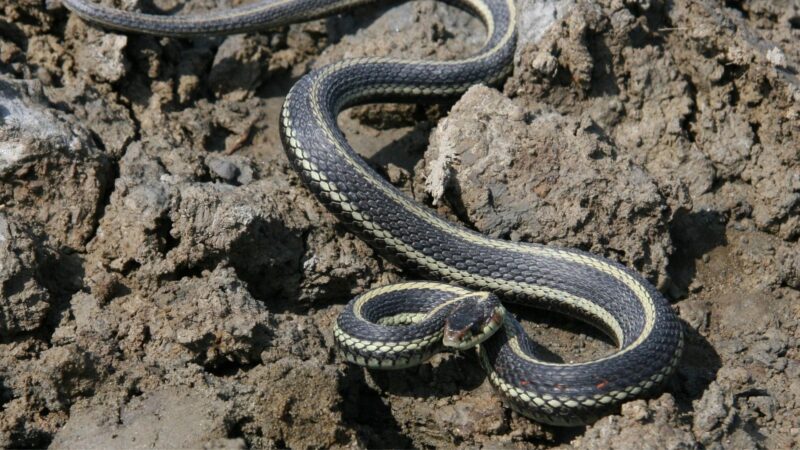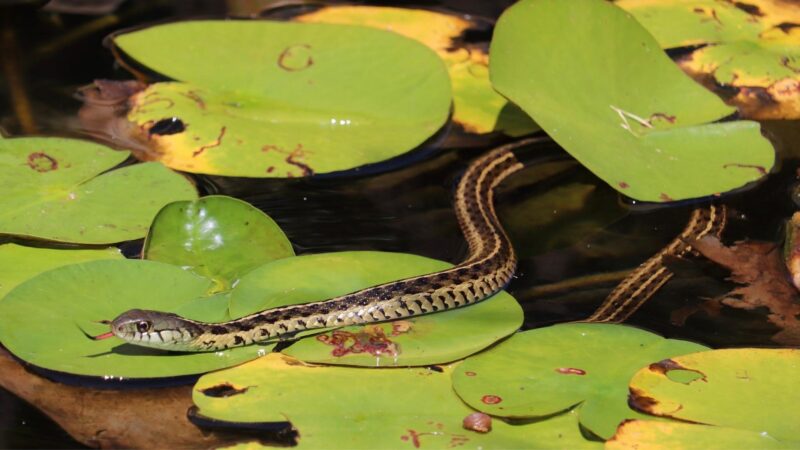Some snakes are not poisonous and venomous, but still, some people have ophidiophobia or fear of snakes. Seeing a snake is inevitable, especially the widespread species like garter snakes.
They tend to enter outbuildings and houses for food hunting. Should you be worried when you see them around?
Are garter snakes poisonous? Garter snakes are not poisonous, so they’re harmless. Their saliva is only toxic to the small animals that they prey on. They bite, but it doesn’t leave poison on someone’s skin, but allergic reactions may arise. However, it rarely happens.
Garter snakes are shy, and they don’t have the impulse to attack. When you come across these snakes, they likely get startled and retreat.
Just let it go on its way. Instead of killing a garter snake when it enters your house, you can safely take it out. Wearing garden gloves provides enough protection for your hands to pick it up.
Since garter snakes are common and you’ll likely see them, it’s best to have a better understanding of their habits and behavior. Everything you need to know is compiled in this article.
Table of Contents
What Is a Garter Snake?

Garter snakes are extensive in North America since they’re originally from the Nearctic region. Their ability to survive extreme weather conditions is a big advantage. However, they’re not found in the southwestern side of the United States because it’s an arid region.
These snakes are considered low-level predators as they only consume small animals. They help control the population of mollusks and insect pests, which are favorable to gardeners.
What Does a Garter Snake Look Like?
The appearance of garter snakes greatly varies in colors and patterns or blotches. Nonetheless, the common look consists of three light stripes that go through the body’s length.
They can be in the colors white, brown, yellow, green, and blue. There’s one prominent stripe in the middle, and two stripes are seen on both sides.
There are dark spots that mingle with the stripes, so checkerboard pattern forms. Most garter snakes have bigger heads than their necks.
They have keeled skin and a red tongue that has a black tip. The belly, chin, and throat have the same coloration as the upper body part.
About Garter Snake

You’ll likely come across garter snakes in spring and summer when they search for food and mate. Apart from the quarter-inch entryway on the wall, they can climb to enter houses and other structures.
If they’re around your garden, you’ll likely see their skin as every garter snake sheds off skin three or four times annually.
How Big Do Garter Snakes Get?
These snakes can grow up to the length of 46 to 137 cm. They’re just 12.5 to 23 cm when born. Females are larger than males.
What Color Are Garter Snakes?
Garter snakes can have blue, brown, green, white, and yellow colors.
Do Garter Snakes Lay Eggs?
Garter snakes don’t lay eggs as they are ovoviviparous, which means that they have embryos inside their bodies. So, the eggs develop inside the mother that delivers live offspring. The gestation period takes two to three months.
How Many Babies Do Garter Snakes Have?
A mother garter snake can deliver 4 to 8 babies. But the average is 10 to 40 offspring. The number varies as it depends on the size of the mother. When she is bigger than the average size, she’ll likely give birth to more babies.
Do Garter Snakes Swim?
Since all snakes can swim, garter snakes are not an exemption.
Where Do Garter Snakes Live?
Since garter snakes can withstand even extreme weather conditions, it has a wide range of habitat. They live in hillsides, meadows, marshes, and woodlands because they like moist and grassy surroundings.
Furthermore, they can reside on the edges of lakes, streams, ditches, and ponds. Also, they can thrive in urban and suburban areas, particularly those with plenty of covering, like vegetation, rocks, debris, logs, and boards.
How Long Do Garter Snakes Live?
When garter snakes are in the wild, they can live up to two years. They have a longer lifespan when kept in captivity as they can live from six to ten years. A few of them can live for two decades.
Do Garter Snakes Bite?

Garter snakes bite when they can’t run away from threats. The coil and bite then release a foul smell and urinate on the attacker.
Do Garter Snakes Have Teeth?
Garter snakes have teeth that seem longer for their body size. Despite being not poisonous, you still need to be careful and avoid getting bitten.
Don’t squeeze the snake as it has a delicate body. You can put it in a cloth bag and set it free in the nearby area.
Are Garter Snakes Venomous?
Garter snakes are not venomous, and their saliva is only toxic to their prey. Some humans who got bitten by a garter snake can have an allergic reaction, but the occurrence is extremely rare.
Based on the research of the University of Nebraska, garter snakes from the wild are not positive for salmonella bacteria or transmissible diseases to humans.
What Do Garter Snakes Eat?

Garter snakes eat small animals like newts, toads, and amphibians that secrete strong chemicals for defense.
What Eats Garter Snakes?
Garter snakes are eaten by various predators. To name a few, birds like hawks, crows, and great blue herons prey on these snakes. Other predators of garter snakes are bullfrogs, milk snakes, squirrels, foxes, raccoons, and snapping turtles.
Are Garter Snakes Aggressive?
Garter snakes are not aggressive, but they also have the instinct to defend themselves. It’s normal among animals, including humans. Once you grab them, they writhe and expel an unpleasant smell. They also pee on their captor.
When they can’t escape when caught, they coil up to make their bodies look enormous. They can strike and bite, but they won’t do these things as long as you don’t touch and chase them. Garter snakes are shy and not aggressive after all.
Are Garter Snakes Dangerous to Dogs?
Garter snakes are not dangerous to dogs and other pets, as confirmed by the University of Florida in their list of non-venomous snakes.
Can You Keep a Garter Snake as a Pet?
You can keep a garter snake as a pet. The commercial pet trade is one of the reasons why their population has declined.
How to Catch a Garter Snake?
You may think about baits, poisons, sprays, and even fumigants to catch garter snakes. In Nebraska, nothing of these things is registered. Better check your local regulations or use these safe traps instead.
Funnel Trap
A funnel trap is utilized to catch a garter snake. This trap is long, and it can be a screen cylinder or wooden box with funnels on both ends. The cylinder or box should be 2 to 3 feet long with a diameter or square of 6 inches.
The funnels have a narrow inner part which is around an inch wide. The other opening should be wider with a measurement of 5 to 6 inches. You have to put this trap in the area where you’ve seen the garter snake. Leave the trap for the entire night or at least half-day before you check if a snake gets in or not.
Sticky Glue Trap
You can use this trap indoors. You can buy it, or you can make one yourself. If you commit to a DIY project, the first step is to get a box that is at least one-foot square and three inches tall. You need to secure the bottom of the box by putting in double-sided tape.
After you prepare the box, you can put it in the quiet, warm area inside your house or a building. Check the box from time to time if the snake gets in it. Once the snake has settled in the box, take it outside and pour some ounces of vegetable oil on the snake, so it can leave by itself.
Summary
Garter snakes are attractive in different colors and patterns. Just like its appearance, it’s one of the snakes that don’t bring harm to people and pets. They’re not poisonous and venomous, so there’s no need to kill them.
In addition, they don’t strike and bite unless they’re being grabbed. If they get inside your house, trap them and set them free outside. They help you get rid of pests in your garden.